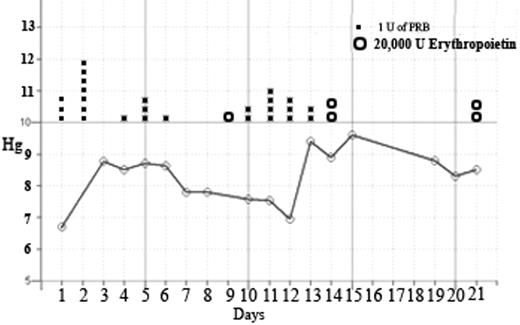Abstract
Purpose: Erythropoietin currently used as a hemopoietic agent, has remarkable hemostatic activity which can be lifesaving in diffuse, uncontrollable bleeding processes. Following is an example case report:
Case presentation: 47 y/o male was admitted with massive GI bleeding and a Hemoglobin (Hg) of 6.7 mg/dl requiring transfusion of 26U Packed Red Blood Cells {PRBC) and 9U of Fresh Frozen Plasma (FFP). The work up revealed a large cell lymphoma infiltrating the mesenteric lymph nodes, the retroperitoneum and the spleen. The small intestine was diffusely infiltrated and bleeding. A portion of the small intestine was resected in an attempt to stop the bleeding; still, the bleeding continued and the Hg could not be raised above 7.8. Erythropoietin 20,000U was administered subcutaneously on day 9 to help correct the anemia. An additional 40,000U were administered on day 14 and 21. Three days after the 2nd dose of Erythropoietin the bowel movement did not appear grossly bloody, the Hg stabilized, and chemotherapy could be administered. After discharge with a follow up of 10 months his Hg stabilized at 12–12.5 mg/dl without any bleeding or transfusion.
Discussion: Erythropoietin has been shown to shorten the bleeding time in chronic renal failure patients on hemodialysis by improving the platelet/subendotelial cell interaction and by raising the platelet count. An enhanced platelet aggregation in response to Ristocetin was noted in Erythropoietin treated uremic patients. This effect was correlated with a rise in platelet Serotonin. Erythropoietin also has been found to have a procoagulant effect in uremic patients by decreasing the protein C, protein S, antithrombin III level. These observations offer an explanation for the clinically observed hemostatic effect of Erythropoietin.
Conclusion: This and other cases have shown that Erythropoietin is a potent hemostatic factor in anemic patients with diffuse uncontrollable bleeding processes, where large amounts of transfused PRBC can barely keep up with the losses and hemostatic procedures can either not be done or failed. As more experience accumulates Erythropoietin may start a second life as a hemostatic factor.
Author notes
Corresponding author


This feature is available to Subscribers Only
Sign In or Create an Account Close Modal